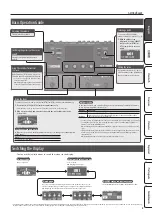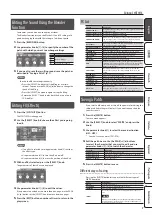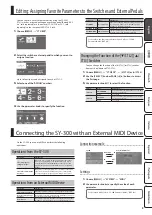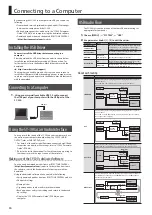
2
Connect the Equipment
Getting Ready
MAIN OUTPUT jacks/SUB OUTPUT jacks
Connect these jacks to your guitar amp, headphones (sold separately), or to PA (LINE).
* Connect your headphones to the MAIN OUTPUT L/PHONES jack.
* If your system is monaural, use only the R/MONO jack.
* If you’re using headphones, don’t connect anything to R/MONO.
DC IN jack
Connect the included AC
adaptor here.
* Use only the included
AC adaptor. Using any
other adaptor may cause
overheating and malfunction.
INPUT jack
Connect your guitar/bass here.
Turning the Power On/Off
This turns the power on/off.
* After you’ve made connections correctly, be sure to
turn
on the power in the order of the SY-300 first, and then
the connected system
. Powering-on in the incorrect
order may cause malfunctions or damage. When turning
the power off,
power-off the connected system first, and
then the SY-300
.
* This unit is equipped with a protection circuit. A brief
interval (a few seconds) after turning the unit on is
required before it will operate normally.
* Before turning the unit on/off, always be sure to turn
the volume down. Even with the volume turned down,
you might hear some sound when switching the unit
on/off. However, this is normal and does not indicate a
malfunction.
Auto Off function
The power to this unit will be turned off automatically after
a predetermined amount of time has passed since it was
last used for playing music, or its buttons or controls were
operated (Auto Off function).
If you do not want the power to be turned off automatically,
disengage the Auto Off function (p. 8).
* Any settings that you are in the process of editing will be
lost when the power is turned off. If you have any settings
that you want to keep, you should save them beforehand.
* To restore power, turn the power on again.
* To prevent malfunction and equipment failure, always turn down the volume, and turn off all the units before making any connections.
USB (
O
) port
Use a commercially available USB 2.0 cable to connect this port to your
computer. It can be used to transfer USB MIDI and USB audio data (p. 10).
THRU/RETURN jacks
Connect an external
effect processor here.
[LIFT/GND] switch
Normally, you can leave this set
to the GND position.
If you’ve connected the THRU/
RETURN jacks to an effect processor
or an amp, a ground loop may occur,
producing noise. If this occurs, you
may be able to eliminate the noise
by moving this switch to the LIFT
position.
MIDI IN, MIDI OUT/THRU connectors
Connect an external MIDI device here.
“Connecting the SY-300 with an External MIDI Device”
EXP /CTL 4, 5 jack
(Connecting to External Pedals)
You can control various parameters by connecting an expression pedal (Roland EV-5: sold separately) or a footswitch (FS-5U, FS-6, FS-7: sold separately) to the EXP/CTL 4, 5
jack.
For details on the settings, refer to “Editing: Assigning Favorite Parameters to the Switches and External Pedals” (p. 9).
POLARITY switch
When Connecting an FS-5U
When Connecting Two FS-5Us
When Connecting an FS-7
When Connecting an FS-6
When connecting EV-5
MODE/POLARITY switch
Cable:
1/4” phone type
,
1/4” phone type
CTL 4
CTL 5
CTL 4
CTL 5
CTL 4
EXP
Cable:
Stereo 1/4” phone type
,
Stereo 1/4” phone type
* Use only the specified
expression pedal (Roland
EV-5: sold separately).
By connecting any other
expression pedals, you risk
causing malfunction and/or
damage to the unit.
Cable:
Stereo 1/4” phone type
,
1/4” phone type x 2
MODE/POLARITY switch
Cable:
Stereo 1/4” phone type
,
1/4” phone type x 2



























